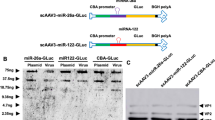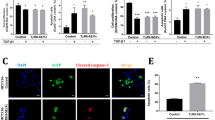Abstract
We had characterized earlier the novel tumor suppressor gene hepatocellular carcinoma suppressor 1 (HCCS1), and demonstrated that expression of exogenous HCCS1 gene in human hepatocarcinoma cells could remarkably suppress their abilities to develop tumors in nude mice and to form colonies in soft agar. In this study, we provide further experimental evidence to confirm the role of HCCS1 as a tumor suppressor gene and investigate its potential in therapeutic applications by using adenovirus vectors. We show that HCCS1 overexpression, mediated by replication-deficient adenovirus, significantly suppressed the growth of human colorectal cancer cells, as well as hepatocellular carcinoma cells in vitro and in vivo. To further improve its antitumor efficacy, we inserted the HCCS1 gene into an oncolytic adenovirus. This HCCS1-armed oncolytic adenovirus exhibited a dramatic inhibitory effect on cancer cells in vitro and in vivo, and led to a complete regression of 50% of established tumor xenografts in nude mice. Taken together, our data suggest that HCCS1 is a promising therapeutic gene for the treatment of human cancers.
This is a preview of subscription content, access via your institution
Access options
Subscribe to this journal
Receive 12 print issues and online access
$259.00 per year
only $21.58 per issue
Buy this article
- Purchase on Springer Link
- Instant access to full article PDF
Prices may be subject to local taxes which are calculated during checkout





Similar content being viewed by others
References
Kondoh N, Wakatsuki M, Hada A, Shuda M, Tanaka K, Arai M et al. Genetic and epigenetic events in human hepatocarcinogenesis. Int J Oncol 2001; 18: 1271–1278.
Zhao XT, Li J, He Y, Lan F, Fu L, Guo J et al. A novel growth suppressor gene on chromosome 17p13.3 with a high frequency of mutation in human hepatocellular carcinoma. Cancer Res 2001; 61: 7383–7387.
Zhao X, He M, Wan D, Ye Y, He Y, Han L et al. The minimum LOH region defined on chromosome 17p13.3 in human hepatocellular carcinoma with gene content analysis. Cancer Lett 2003; 190: 221–232.
Vile RG, Russell SJ, Lemoine NR . Cancer gene therapy: hard lessons and new courses. Gene Therapy 2000; 7: 2–8.
Vorburger SA, Hunt KK . Adenoviral gene therapy. Oncologist 2002; 7: 46–59.
Zhang ZL, Zou WG, Luo CX, Li BH, Wang JH, Sun LY et al. An armed oncolytic adenovirus system, ZD55-gene, demonstrating potent antitumoral efficacy. Cell Res 2003; 13: 481–489.
Liu XY, Gu JF . Targeting gene-virotherapy of cancer. Cell Res 2006; 16: 25–30.
Rodrigues NR, Rowan A, Smith ME, Kerr IB, Bodmer WF, Gannon JV et al. p53 mutations in colorectal cancer. Proc Natl Acad Sci USA 1990; 87: 7555–7559.
Zhao H, Xu Y . Mad-overexpression down regulates the maliganant growth and p53 mediated apoptosis in human hepatocellular carcinoma BEL7404 cells. Cell Res 1999; 9: 51–59.
Pei Z, Chu L, Zou W, Zhang Z, Qiu S, Qi R et al. An oncolytic adenoviral vector of Smac increases antitumor activity of TRAIL against HCC in human cells and in mice. Hepatology 2004; 39: 1371–1381.
Liu XY, Qiu SB, Zou WG, Pei ZF, Gu JF, Luo CX et al. Effective gene-virotherapy for complete eradication of tumor mediated by the combination of hTRAIL (TNFSF10) and plasminogen k5. Mol Ther 2005; 11: 531–541.
Zhang Z, Zou W, Wang J, Gu J, Dang Y, Li B et al. Suppression of tumor growth by oncolytic adenovirus-mediated delivery of an antiangiogenic gene, soluble Flt-1. Mol Ther 2005; 11: 553–562.
Zhao L, Gu J, Dong A, Zhang Y, Zhong L, He L et al. Potent antitumor activity of oncolytic adenovirus expressing mda-7/IL-24 for colorectal cancer. Hum Gene Ther 2005; 16: 845–858.
Zhang Y, Gu J, Zhao L, He L, Qian W, Wang J et al. Complete elimination of colorectal tumor xenograft by combined manganese superoxide dismutase with tumor necrosis factor-related apoptosis-inducing ligand gene virotherapy. Caner Res 2006; 66: 4291–4298.
Qi R, Gu G, Zhang Z, Yang K, Li B, Fan J et al. Potent antitumor efficacy of XAF1 delivered by conditionally replicative adenovirus vector via caspase-independent apoptosis. Cancer Gene Ther 2007; 14: 82–90.
Gan Y, Zhao X, Hu J, Wang Z, Zhao X . HCCS1 overexpression induces apoptosis via cathepsin D and intracellular calcium, and HCCS1 disruption in mice causes placental abnormality. Cell Death Differ 2008 May 30, [E-pub ahead of print; doi:10.1038/cdd.2008.73].
Guicciardi ME, Leist M, Gores GJ . Lysosomes in cell death. Oncogene 2004; 23: 2881–2890.
Chwieralski CE, Welte T, Bühling F . Cathepsin-regulated apoptosis. Apoptosis 2006; 11: 143–149.
Kos J, Lah TT . Cysteine proteinases and their endogenous inhibitors: target proteins for prognosis, diagnosis and therapy in cancer (review). Oncol Rep 1998; 5: 1349–1361.
Koblinski JE, Ahram M, Sloane BF . Unraveling the role of proteases in cancer. Clin Chim Acta 2000; 291: 113–135.
Fehrenbacher N, Jäättelä M . Lysosomes as targets for cancer therapy. Cancer Res 2005; 65: 2993–2995.
Conibear E, Stevens TH . Vps52p, Vps53p, and Vps54p form a novel multisubunit complex required for protein sorting at the yeast late Golgi. Mol Biol Cell 2000; 11: 305–323.
Leiwen H, Meinhold-Heerlein I, Oliveira V, Schwarzenbacher R, Luo G, Wadle A et al. Characterization of the human GARP (Golgi associated retrograde protein) complex. Exp Cell Res 2005; 306: 24–34.
Press B, Feng Y, Hoflack B, Wandinger-Ness A . Mutant rab7 causes the accumulation of cathepsin D and cation-independent mannose 6-phosphate receptor in an early endocytic compartment. J Cell Biol 1998; 140: 1075–1089.
Acknowledgements
We thank Lanying Sun for her excellent technical assistance in cell culture, and Dr Yiping Jing and Dr Yangxin Zhao for the discussion. This work was supported by the grants from the Key Programs of the National Natural Science Foundation of China (No. 30330350), Hi-Tech Research Development Program of China (863 Program, No. 2007AA021006), the Key Project of the Chinese Academy of Sciences (No. KSCX2-YW-R-09), and Shanghai Committee of Science and Technology (No. 04XD14015).
Author information
Authors and Affiliations
Corresponding authors
Rights and permissions
About this article
Cite this article
Gan, Y., Gu, J., Cai, X. et al. Adenovirus-mediated HCCS1 overexpression elicits a potent antitumor efficacy on human colorectal cancer and hepatoma cells both in vitro and in vivo. Cancer Gene Ther 15, 808–816 (2008). https://doi.org/10.1038/cgt.2008.52
Received:
Revised:
Accepted:
Published:
Issue Date:
DOI: https://doi.org/10.1038/cgt.2008.52
Keywords
This article is cited by
-
Wilforine inhibits rheumatoid arthritis pathology through the Wnt11/β-catenin signaling pathway axis
Arthritis Research & Therapy (2023)
-
A yeast phenomic model for the influence of Warburg metabolism on genetic buffering of doxorubicin
Cancer & Metabolism (2019)
-
Adenoviral gene therapy in hepatocellular carcinoma: a review
Hepatology International (2013)
-
HCCS1-armed, quadruple-regulated oncolytic adenovirus specific for liver cancer as a cancer targeting gene-viro-therapy strategy
Molecular Cancer (2011)



